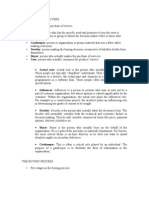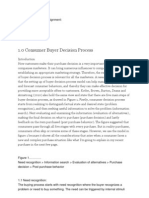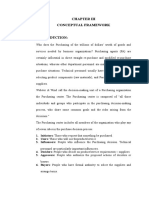MMMMMMMMMMMMMMMMMMMMMMMMMMMMMM M M M M MMMM
MMMMMMMMMMMMMMMMMMMMMMMMMMMMMM M M M M MMMM
Uploaded by
Avinash JhaCopyright:
Available Formats
MMMMMMMMMMMMMMMMMMMMMMMMMMMMMM M M M M MMMM
MMMMMMMMMMMMMMMMMMMMMMMMMMMMMM M M M M MMMM
Uploaded by
Avinash JhaOriginal Title
Copyright
Available Formats
Share this document
Did you find this document useful?
Is this content inappropriate?
Copyright:
Available Formats
MMMMMMMMMMMMMMMMMMMMMMMMMMMMMM M M M M MMMM
MMMMMMMMMMMMMMMMMMMMMMMMMMMMMM M M M M MMMM
Uploaded by
Avinash JhaCopyright:
Available Formats
Question: Answer:
state the various stages in the decision making process of customers?
Stages of the Consumer Buying Process
Six Stages to the Consumer Buying Decision Process. Actual purchasing is only one stage of the process. Not all decision processes lead to a purchase. All consumer decisions do not always include all 6 stages, determined by the degree of complexity
The 6 stages are: Problem Recognition(awareness of need)
Information search Evaluation of AlternativesPurchase decisionPurchase Post-Purchase Evaluation-
The customer decision-making process and its five stages
Studies show that buying process acts as a sieve, where customers are inadvertently filter out at each stage of their decision-making process. Question:2 what is involvement? How does it affect the consumer decision making process? Answer: Involvement :
When consumers decide to buy a product based on the interest and importance of the product to them, this is defined as involvement level.
Involvement level divides into two categories:
high involvement : High involvement purchases are higher priced items such as luxury products. With these purchases, the consumer will research to eliminate the risk. For example, a luxury car is a high involvement purchase. It is risky because the consumer will pay a high amount of money toward the purchase. To spend this much money without research and possibly buy a lemon is risky behavior. Thus, consumers research high involvement purchases such as luxury cars, motorcycles.
low involvement: low involvement purchases, there is little risk if any at all. Examples of low involvement items are toothpaste, bar soap, snack foods, etc. Consumers do not research or put forth a major decision making effort when buying these products. In other words, they automatically buy the product and there is little involvement.
How Involvement Level Affects Consumer Buying: Buyers become
psychologically involved when making the decision to buy a product. However, there are levels that determine the involvement. For example, if I'm out running errands and I'm thirsty, I will run into a convenience store and grab a bottle of water. Usually, I will grab
any cold bottle of water and purchase it. It is a quick purchase that will probably last under a minute. Thus, my involvement level is low when buying my bottle of water. However, my involvement level raises when I start to notice that I like one particular brand of water. So every time I run errands, I stop in the convenience store and search for that particular brand and purchase it. This is limited decision making involvement. Now, let's say I'm tired of spending money on bottled water every time I run errands. I want to purchase a water distiller, which is an expensive purchase of $350. I decide to research water distillers online, reading through consumer reviews, product reviews and comparing and contrasting each distiller. After a few days of researching online, I finally make my choice. That is a high involvement level because I've invested a lot of time and energy on my decision to buy Long-Answer Questions
Question:1
Differentiate between consumer buying behavior and organizational buying behavior?
Answer
DIFFERENTIATIE BETWEEN ORGANIZATIONAL BUYING AND CONSUMER BUYING Organizational consumers purchase for:
y y y
further production, usage in operating the organization, and/or resale to other consumers
Final (or ultimate) consumers purchase for:
y y y
personal, family, or household use
What is the difference between the terms consumer, buyer, and customer? B-to-B marketing business to business marketing Question: 2 Explain various steps in the decision making process in business organizations. Answer
A-3 Organizational consumers purchase for:
y y y
further production, usage in operating the organization, and/or resale to other consumers
Final (or ultimate) consumers purchase for:
y y y
personal, family, or household use
Think about the hundreds of components that are used in producing, say, a telephone. Each one of those component parts had to be sold to the telephone manufacturer. The part had to be designed such that it met the needs of the buyer, it had to be promoted in a way to make the buyer aware that it was available, it had to be distributed at the times and in the quantities that the buyer needed, and all of this had to be done in such a way that the part could be produced and delivered at a competitive price. There are hundreds of parts, wires, screws, glues, paints, and such that are marketed before the telephone is itself finally produced, marketed, and sold to a final household consumer.
A-4 The customers go through a five-stage decision-making process in any purchase:
Problem Recognition In this information processing model, the consumer buying process begins when the buyer recognizes a problem or need. For example, Doug may realize that his best suit doesn t look contemporary any more. Or, Kathleen may recognize that her personal computer is not performing as well as she thought it should. These are the kinds of problem that we as consumers encounter all the time. When we found out a difference between the actual state and a desired state, a problem is recognized. When we find a problem, we usually try to solve the problem. We, in other words, recognize the need to solve the problem. But how?
Information Search When a consumer discovers a problem, he/she is likely to search for more information. Kathleen may simply pay more attention to product information of a personal computer. She becomes more attentive to computer ads, computers purchased by her friends, and peer conversations about computers. Or, she may more actively seek information by visiting stores, talking to friends, or reading computer magazines, among others. Through gathering information, the consumer learns more about some
brands that compete in the market and their features and characteristics. Theoretically, there is a total set of brands available to Kathleen, but she will become aware of only a subset of the brands (awareness set) in the market. Some of these brands may satisfy her initial buying criteria, such as price and processing speed (consideration set). As Kathleen proceeds to more information search, only a few will remain as strong candidates (choice set).
Evaluation and Selection of Alternatives How does the consumer process competitive brand information and evaluate the value of the brands? Unfortunately there is no single, simple evaluation process applied by all consumers or by one consumer in all buying situations.
One dominant view, however, is to see the evaluation process as being cognitively driven and rational. Under this view, a consumer is trying to solve the problem and ultimately satisfying his/her need. In other words, he/she will look for problem-solving benefits from the product. The consumer, then, looks for products with a certain set of attributes that deliver the benefits. Thus, the consumer sees each product as a bundle of attributes with different levels of ability of delivering the problem solving benefits to satisfy his/her need. The distinctions among the need, benefits, and attributes are very important. One useful way to organize the relationships among the three is a hierarchical one (Figure 2). Although simplified, Figure 2 is an example of how a bundle of attributes (i.e., a product or, more specifically, personal computer) relates to the benefits and underlying needs of Kathleen.
Underlying Needs
Helps Me Survive Babson MBA Pogram
Benefits
Portability
Doesnt Break down
Economy
Computational Horse Power
Warranty
Attributes
Size
Brand Reputation
Price
Software Bundle
CPU Speed
Hard Drive Size GlobeNet Ready
Figure 2
Hierarchical View of Needs, Benefits, and Attributes
From this figure and the preceding discussion, you might recognize that the product attributes are relevant and important only to the extent that they lead to a certain set of benefits. Likewise, benefits are meaningful only if they can address the problem and be instrumental to satisfy the underlying need. As the underlying need is often personal, consumers differ as to their beliefs about what product benefits and attributes are more (or less) important and relevant in satisfying their needs. Based on their personal judgment on importance of benefits and attributes, consumers develop a set of attitudes (or preferences) toward the various brands. One may express his/her preferences of the brands in terms of ranking, probability of choice, and so forth.
Decision Implementation To actually implement the purchase decision, however, a consumer needs to select both specific items (brands) and specific outlets (where to buy) to resolve the problems. There are, in fact, three ways these decisions can be made: 1) simultaneously; 2) item first, outlet second; or 3) outlet first, item second.i In many situations, consumers engage in a simultaneous selection process of storesii and brands. For example, in our Kathleen s personal computer case, she may select a set of brands based on both the product s technical features (attributes) and availability of brands in the computer stores and
mail-order catalogs she knows well. It is also possible, that she decides where to buy (e.g., CompUSA in her neighborhood) and then chooses one or two brands the store carries. Once the brand and outlet have been decided, the consumer moves on to the transaction ( buying ).
Post-purchase Evaluation Post-purchase evaluation processes are directly influenced by the type of preceding decision-making process. Directly relevant here is the level of purchase involvement of the consumer. Purchase involvement is often referred to as the level of concern for or interest in the purchase iii situation, and it determines how extensively the consumer searches information in making a purchase decision.iv Although purchase involvement is viewed as a continuum (from low to high), it is useful to consider two extreme cases here. Suppose one buys a certain brand of product (e.g., Diet Pepsi) as a matter of habit (habitual purchase). For him/her, buying a cola drink is a very low purchase involvement situation, and he/she is not likely to search and evaluate product information extensively. In such a case, the consumer would simply purchase, consume and/or dispose of the product with very limited postpurchase evaluation, and generally maintain a high level of repeat purchase motivation (Figure 3).
You might also like
- Ahead of the Curve: Using Consumer Psychology to Meet Your Business GoalsFrom EverandAhead of the Curve: Using Consumer Psychology to Meet Your Business GoalsNo ratings yet
- Buying Decision ProcessDocument7 pagesBuying Decision ProcessEkaur KaurNo ratings yet
- Bomba Grindex Sandy NDocument22 pagesBomba Grindex Sandy Ncarlos sanabria ninamangoNo ratings yet
- Consumer MarketingDocument9 pagesConsumer MarketingatlcelebrityNo ratings yet
- Consumer Decision Making Process (Reference)Document9 pagesConsumer Decision Making Process (Reference)May Oo LayNo ratings yet
- Consumer Behaviour and Rural Marketing AssignmentDocument15 pagesConsumer Behaviour and Rural Marketing Assignmentjainpiyush_1909No ratings yet
- CB Ch2Document6 pagesCB Ch2shanemathew758No ratings yet
- Consumer Buying BehaviourDocument12 pagesConsumer Buying BehaviourJoana Veerapen100% (2)
- Consumer Buying ProcessDocument6 pagesConsumer Buying ProcessMAHENDRA SHIVAJI DHENAKNo ratings yet
- How Do Customers Buy?Document5 pagesHow Do Customers Buy?Vikas KhobragadeNo ratings yet
- Consumer Decision Making ProcessDocument9 pagesConsumer Decision Making ProcessKhudadad NabizadaNo ratings yet
- Un Doing Job MIDocument10 pagesUn Doing Job MIpriyaNo ratings yet
- Consumer Buying DecisionDocument6 pagesConsumer Buying DecisionRatna Sari UtamiNo ratings yet
- Consumer BehaviourDocument22 pagesConsumer BehaviourNISHANTNo ratings yet
- Consumer Buying Behavior Concept - OdtDocument5 pagesConsumer Buying Behavior Concept - OdtPrithviraj KumarNo ratings yet
- Consumer Buying Decision ProcessDocument6 pagesConsumer Buying Decision ProcessJamyang Palmu KatukNo ratings yet
- The Consumer Buying Decision ProcessDocument10 pagesThe Consumer Buying Decision ProcessakmohideenNo ratings yet
- Buying Behaviour of A CustomerDocument8 pagesBuying Behaviour of A CustomerbhowalchitralekhaNo ratings yet
- BUS 5112 Written Assignment 2Document6 pagesBUS 5112 Written Assignment 2Khadijat Smile100% (1)
- Lesson 35: Decision Making Process: Unit Iv Consumer Decision-Making Chapter 12: Consumer Decision-MakingDocument9 pagesLesson 35: Decision Making Process: Unit Iv Consumer Decision-Making Chapter 12: Consumer Decision-MakingRohan BahriNo ratings yet
- Chapter #2Document7 pagesChapter #2didimosdore16No ratings yet
- World of Marketing - Module 3 - BookletDocument43 pagesWorld of Marketing - Module 3 - BookletGift SimauNo ratings yet
- Customer DetailDocument28 pagesCustomer Detailhiren_shah007No ratings yet
- Chapter-Three Understand Consumer Behavior 3.1 Consumer Buying BehaviorDocument11 pagesChapter-Three Understand Consumer Behavior 3.1 Consumer Buying BehaviorAhmed HonestNo ratings yet
- Consumer Decision MakingDocument27 pagesConsumer Decision Makingharshbaghel656No ratings yet
- Cha3 Pric-2013Document7 pagesCha3 Pric-2013Elias Shetemam BeshirNo ratings yet
- Consumer Decisiion MakingDocument4 pagesConsumer Decisiion MakingJitendra SinghNo ratings yet
- 1.0 Consumer Buyer Decision ProcessDocument10 pages1.0 Consumer Buyer Decision ProcessWena MusthafaNo ratings yet
- Complex Buying Behavior - Final Notes - Doc (N)Document42 pagesComplex Buying Behavior - Final Notes - Doc (N)Niraj KherajaniNo ratings yet
- Marketing AssignmentDocument6 pagesMarketing AssignmentISHITA KAMBLENo ratings yet
- Consumer Decision Making 6Document40 pagesConsumer Decision Making 6yaduvanshiak05No ratings yet
- Problem RecognitionDocument4 pagesProblem RecognitionChelle RishNo ratings yet
- Chapter 3Document19 pagesChapter 3olmezestNo ratings yet
- CB Assignment01Document8 pagesCB Assignment01Hira RazaNo ratings yet
- Chapter No.9. Consumer Decision Process & Problem RecognitionDocument16 pagesChapter No.9. Consumer Decision Process & Problem RecognitionMichelle Danika MarquezNo ratings yet
- CBAssignment HoangThuyLinhDocument6 pagesCBAssignment HoangThuyLinhlinhcindyNo ratings yet
- How Do Customers Buy?: Buyer Behaviour - Decision-Making ProcessDocument4 pagesHow Do Customers Buy?: Buyer Behaviour - Decision-Making ProcessRanobir DeyNo ratings yet
- 2.theoretical Background and Secondary DataDocument16 pages2.theoretical Background and Secondary Datamayaappu.2001No ratings yet
- Alternative Evaluation Decision Rules-And-Purchase DecisionDocument22 pagesAlternative Evaluation Decision Rules-And-Purchase Decisionjakhar30No ratings yet
- MarketingDocument3 pagesMarketingAuroraNo ratings yet
- Marketing Week 2Document13 pagesMarketing Week 2asnairahNo ratings yet
- Consumer Behavior Decision Process: What Is Decision MakingDocument14 pagesConsumer Behavior Decision Process: What Is Decision Makinggul_e_sabaNo ratings yet
- E-Note 14811 Content Document 20240103110324AMDocument34 pagesE-Note 14811 Content Document 20240103110324AMytmandar29No ratings yet
- Chapter 3, Consumer Decision MakingDocument7 pagesChapter 3, Consumer Decision MakingMuthusamy SenthilkumaarNo ratings yet
- Consumer Market and Consumer Purchasing BehaviorDocument8 pagesConsumer Market and Consumer Purchasing BehaviorScribdTranslationsNo ratings yet
- Chapter 1Document19 pagesChapter 1mohan ksNo ratings yet
- Decision Making in Consumer BehaviorDocument12 pagesDecision Making in Consumer BehaviorSanober Iqbal100% (1)
- The Consumer Buying Decision ProcessDocument8 pagesThe Consumer Buying Decision Processmeryycortezz78No ratings yet
- Assignment#2 Models of Buyer BehaviorDocument4 pagesAssignment#2 Models of Buyer Behaviorhiba khanNo ratings yet
- Assignment#2 Models of Buyer BehaviorDocument3 pagesAssignment#2 Models of Buyer Behaviorhiba khanNo ratings yet
- The Buying Decision ProcessDocument4 pagesThe Buying Decision ProcessAbdullah FaisalNo ratings yet
- 4 PDFDocument5 pages4 PDFHani Bin Faisal AhammadNo ratings yet
- Unit 15 Purchase Process & Post-Purchase Behaviour: ObjectivesDocument10 pagesUnit 15 Purchase Process & Post-Purchase Behaviour: ObjectivesAkki KwatraNo ratings yet
- Chapter IIIDocument33 pagesChapter IIIRahul JNo ratings yet
- The Research On Consumer Decision Process and Problem RecognitionDocument4 pagesThe Research On Consumer Decision Process and Problem RecognitionTJSNo ratings yet
- Complex Buying Behavior Final Notes Doc NDocument37 pagesComplex Buying Behavior Final Notes Doc Nhuzaifa anwarNo ratings yet
- My FinalDocument67 pagesMy FinalkaurpreetgillNo ratings yet
- Marketbusters (Review and Analysis of Mcgrath and Macmillan's Book)From EverandMarketbusters (Review and Analysis of Mcgrath and Macmillan's Book)No ratings yet
- VOR NDB Numerical Test 1Document13 pagesVOR NDB Numerical Test 1sneha jauhariNo ratings yet
- TC1150 Cone Crusher Overview Rev01Document20 pagesTC1150 Cone Crusher Overview Rev01Luis Antonio Vega Parangueo100% (4)
- 2 Wire Fourdrinier Type Paper Machine For The Production of Corrugated Base Kraft Paper Width 2550mm PDFDocument35 pages2 Wire Fourdrinier Type Paper Machine For The Production of Corrugated Base Kraft Paper Width 2550mm PDFRahmath0% (1)
- Degradation Effects On Combined Cycle Power Plant Performance - Part II: Steam Turbine Cycle Component Degradation EffectsDocument6 pagesDegradation Effects On Combined Cycle Power Plant Performance - Part II: Steam Turbine Cycle Component Degradation Effectswolf_nsNo ratings yet
- Balancing of Rigid & Flexible Rotors PDFDocument6 pagesBalancing of Rigid & Flexible Rotors PDFJHON ANGEL VARGAS HUAHUASONCCO100% (1)
- Logical Effort2Document32 pagesLogical Effort2manish mangalamNo ratings yet
- Law of Sales of GoodsDocument16 pagesLaw of Sales of GoodsSarah M'dinNo ratings yet
- Policy Note 2023-24Document164 pagesPolicy Note 2023-24Sunder RajagopalanNo ratings yet
- Module Adobe Premiere PDFDocument10 pagesModule Adobe Premiere PDFFAISAL FIRDAUS BIN TUAH -No ratings yet
- LabReport Total S1 2022 2023Document39 pagesLabReport Total S1 2022 2023Khôi ĐăngNo ratings yet
- Introduction To Computer Science and Programming in C LanguageDocument45 pagesIntroduction To Computer Science and Programming in C LanguageTomiwa FakolaNo ratings yet
- Autocad Shortcut Keys 2008Document4 pagesAutocad Shortcut Keys 2008Emmanuel S SombilonNo ratings yet
- DehDocument34 pagesDehAnand Swami100% (2)
- DeadlocksDocument38 pagesDeadlocksM Hussnain ShabbirNo ratings yet
- Delphi Informant Magazine Vol 6 No 4Document34 pagesDelphi Informant Magazine Vol 6 No 4sharkfinmikeNo ratings yet
- Jurassic Park Operation Genesis CheatsDocument7 pagesJurassic Park Operation Genesis CheatsAgil MuliawanNo ratings yet
- S10 Operating Institutions PDFDocument63 pagesS10 Operating Institutions PDFpham quang vinh100% (1)
- FifaDocument4 pagesFifacesarNo ratings yet
- Term Paper On Career DevelopmentDocument4 pagesTerm Paper On Career Developmentc5nah867100% (1)
- Conversation Corner Where in The World The CityDocument2 pagesConversation Corner Where in The World The CityPatricia PerezNo ratings yet
- Report Submitted To: Fiza BalouchDocument18 pagesReport Submitted To: Fiza BalouchMehreen Khalid100% (1)
- SJC-ESE Routine For II, IV & VI Semester 2023 (UG)Document7 pagesSJC-ESE Routine For II, IV & VI Semester 2023 (UG)Imti RoadNo ratings yet
- Canon XH-A1 3CCD HDV Camcorder, 1080i, 16:9, 20x Lens, 24f ModeDocument5 pagesCanon XH-A1 3CCD HDV Camcorder, 1080i, 16:9, 20x Lens, 24f ModeLuna Deadwood KaryotakisNo ratings yet
- GR00001000 00Document56 pagesGR00001000 00Art Del R SalongaNo ratings yet
- Honeycomb StructureDocument8 pagesHoneycomb StructureGunaseelan VNo ratings yet
- ACE Local ManufacturingDocument17 pagesACE Local Manufacturingr0ll3rNo ratings yet
- BookDocument1,240 pagesBookAmitNo ratings yet
- Etd Tamu 2004A PETE Seo 1Document132 pagesEtd Tamu 2004A PETE Seo 1Philip Jezreel SugaboNo ratings yet
- Mintel 2023 Global BPC TrendsDocument20 pagesMintel 2023 Global BPC TrendsDoris Kuo100% (1)

























































































